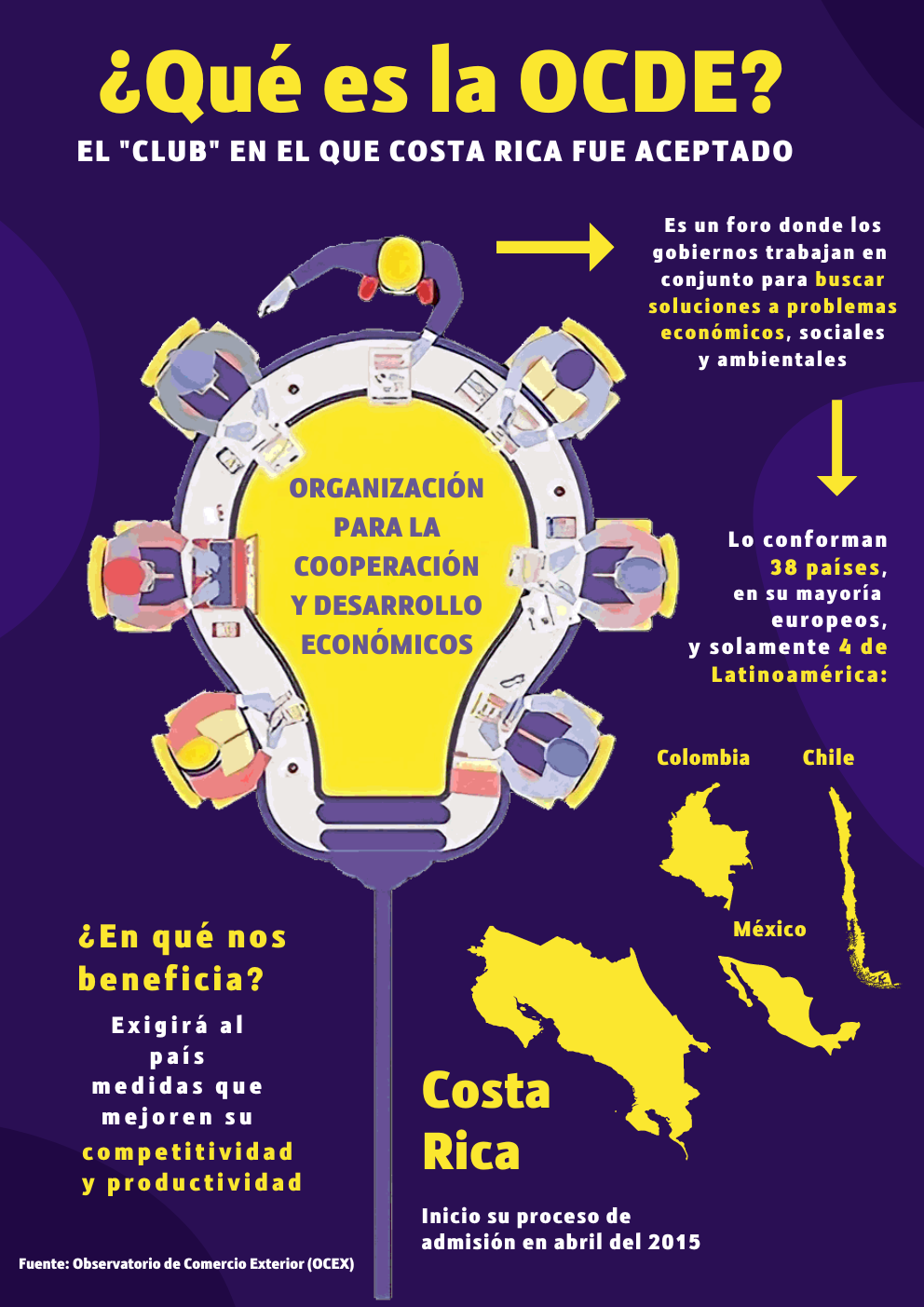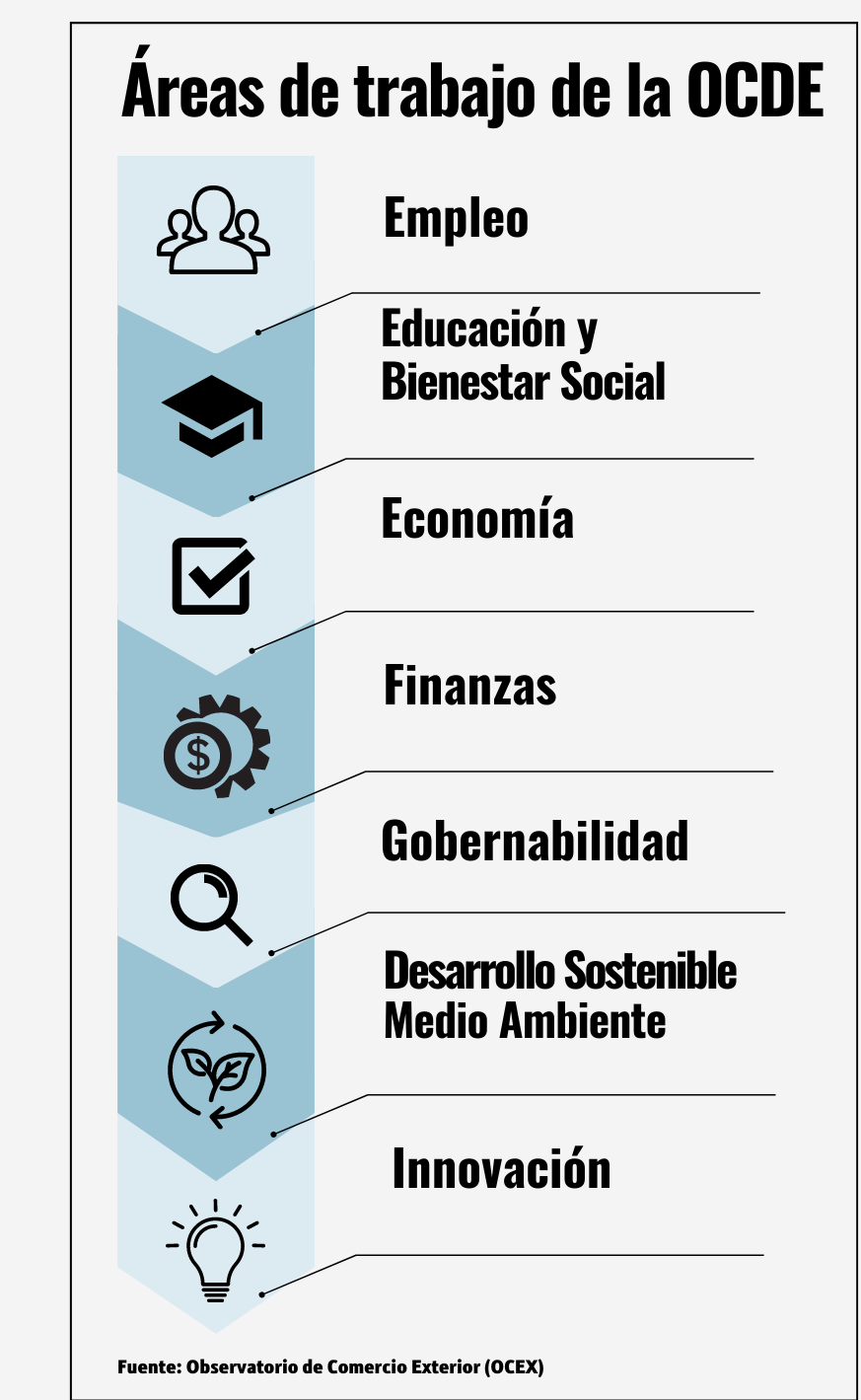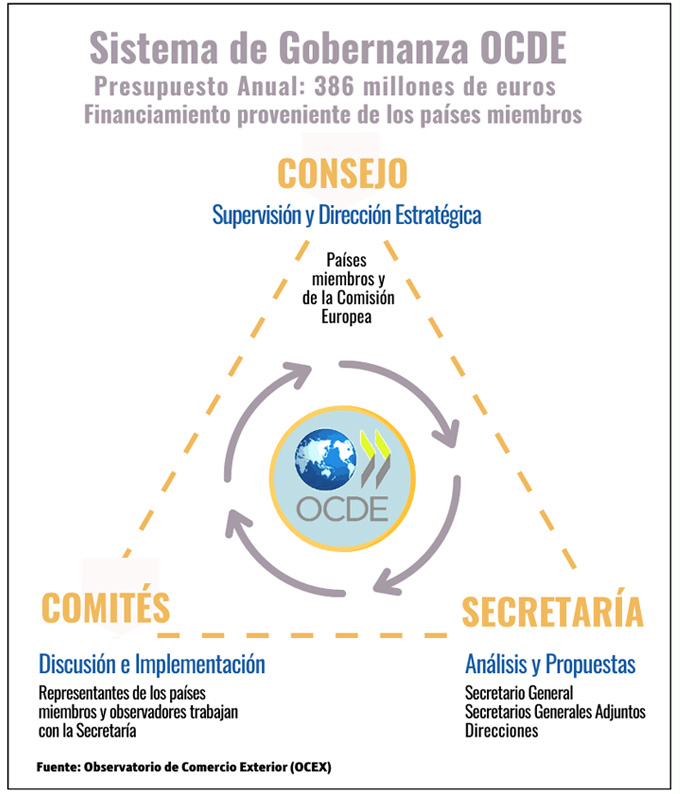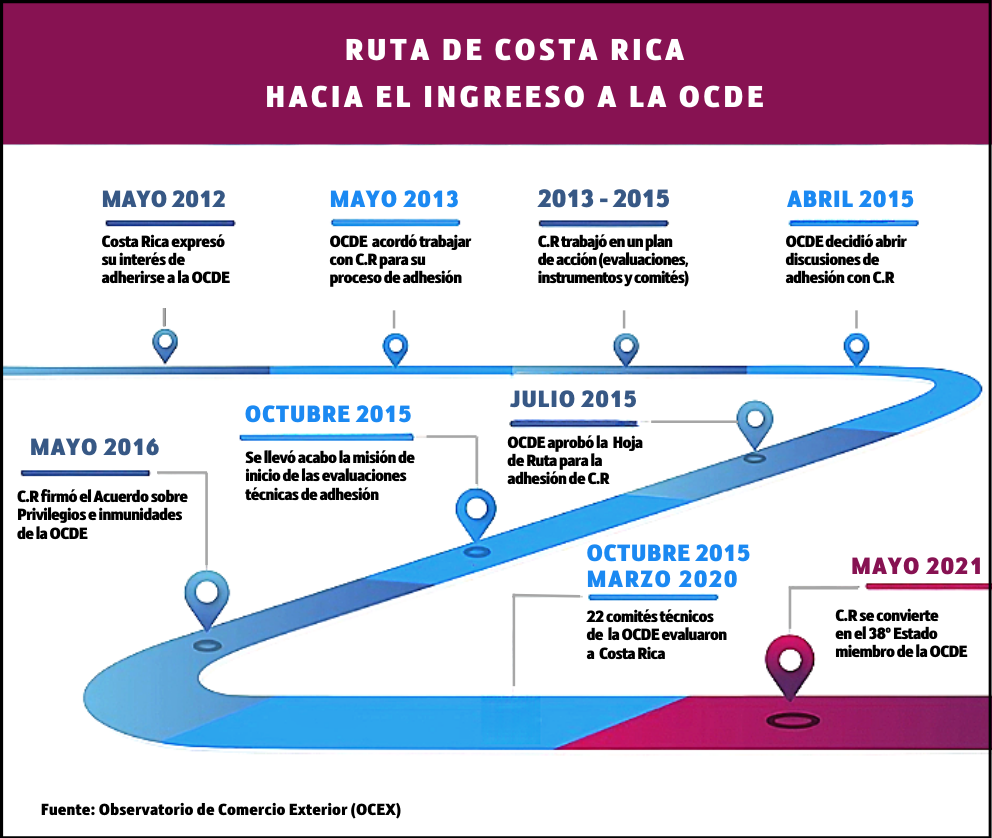General description of the OECD
MBA. Hellen Ruiz Hidalgo
Strategic Communicator
Foreign Trade Observatory (OCEX)
Vice-Rectory for Research - Distance Learning State University (UNED)
 Historical background. With the end of World War II, in view of the difficult situation in which the countries of Europe had found themselves and in the context of a world divided into blocs in the midst of the Cold War, the United States saw the need for European reconstruction. In 1947, George C. Marshall, U.S. Secretary of State, understood the negative political effects that a Europe with a destroyed economy would have for his country.
Historical background. With the end of World War II, in view of the difficult situation in which the countries of Europe had found themselves and in the context of a world divided into blocs in the midst of the Cold War, the United States saw the need for European reconstruction. In 1947, George C. Marshall, U.S. Secretary of State, understood the negative political effects that a Europe with a destroyed economy would have for his country.
Marshall's famous speech at Harvard University laid down the principles of a paradigmatic European reconstruction aid plan. There Marshall laid the basic premises of the American interest in a massive economic aid plan when he said "Apart from the demoralizing effect on the world at large and the possibilities of riots arising as a result of the desperation of the people affected, the consequences for the economy of the United States should be obvious to all. It is only logical that the United States should do everything in its power to contribute to the restoration of normal economic health in the world, without which there can be no political stability and no assured peace".
With the aim of administering American aid, facilitating trade, granting credits and encouraging the free movement of capital, on April 16, 1948, 16 European countries convened what was called the Conference of the 16. This convocation allowed the establishment of an organization to coordinate recovery programs and, in particular, to supervise the distribution of American aid.
This is how the Organization for European Economic Cooperation (OEEC) came into being. This organization for coordinating cooperation can be seen as complementary to the Bretton Woods institutions and is the forerunner of the Organization for Economic Cooperation and Development. Although its official name is OECD, from the acronym derived from its official name in English, which is "Organization for Economic Co-operation and Development", in this information capsule we will use the acronym derived from its name in Spanish: OCDE.
When, in 1961, the United States and Canada joined it, it became the OECD. The founding Convention that transformed the OECS into the OECD was signed at the Chateau de la Muette in Paris on December 14, 1960 and entered into force on September 30, 1961. Its functions gradually evolved into an institution for compiling studies and statistics on economic performance, comparative analysis of public policies and a forum for the exchange of experiences and recommendations.
What is the OECD? The Organization for Economic Co-operation and Development (OECD) is an international co-operation institution in which 38 countries currently participate. Its objective is to share experiences, coordinate and promote best practices in public policies in different areas of government activity. It has been in operation for 62 years, since its official foundation in 1961, and has 75 years of history and experience if we take into account the lessons learned from its organization and predecessor, the OECS, in charge of European reconstruction since 1948, after World War II.
Its objective is to coordinate economic and social policies. To coordinate economic and social policies. Its headquarters are located at the Château de la Muette, in Paris (France). Its official languages are French and English. The number, ideological and political diversity, as well as the cultural diversity of its member countries have made it the most influential world forum for study and reflection on public policies. It analyzes experiences, studies specific conditions in its member countries and offers recommendations on a wide range of issues of national or international relevance.
Its mandate is unique in that it covers all areas of public policy that are relevant to its purposes. This characteristic is unique among all international organizations and allows it to strengthen a multidisciplinary approach to the problems and public policies it addresses, examines and recommends best practices through various initiatives. This enables it to provide global and wide-ranging responses to complex challenges.
and recommends best practices through various initiatives. This enables it to provide global and wide-ranging responses to complex challenges.
The protagonists of this organization are the member governments and various interest groups or issue-based groupings. At the OECD, representatives of member countries meet to exchange information and to harmonize policies with the aim of maximizing their economic growth and contributing to their own and other countries' development, even if they are not members.
The OECD has become a decisive node for the flow of information on a wealth of data of all kinds. This wealth of information derives from its permanent interrelationship with all types of national and multilateral bodies, governments and civil society organizations, and with all the international bodies derived from the Bretton Woods Agreement, such as the World Bank, the International Monetary Fund and the World Trade Organization.
It publishes hundreds of titles annually on topics including agriculture, scientific research, capital markets, tax structures, energy resources, air pollution, educational development and development aid. Its bimonthly magazine, The OECD Observer, is a valuable source of information on political, economic and related social issues. The annual evaluations of the performance of the public policies of the various member countries are of great informative value and generate recommendations for public policy changes.
Referred to as the "Club of Rich Countries", the role of this organization in international financial and technical cooperation has been of particular interest. The vast majority of development aid comes from OECD countries. In fact, the OECD created the Development Assistance Committee (DAC), a group of countries that coordinate resources for emerging economies. Almost all DAC countries are members of the OECD. In addition to Western European countries, the DAC includes the United States, Canada, Japan, Australia and New Zealand.
Its lines of action. The OECD is a knowledge center, strategically positioned for the best and broadest data collection and analysis, based on the exchange of experiences, which permits it to identify and share best practices. From a broad base of experiences, studies, exchanges and discussions, it has developed the capabilities and skills to set international standards and norms and to provide policy advice and recommendations to its member countries. This has made it an optimal forum for:
- sharing experiences and, at the same time, collecting and organizing empirical data statistically;
- seek solutions to shared economic, social and environmental challenges;
- identify best practices in public policy and
- develop evidence-based international standards
Areas of study, milestones and recommendations: https://www.oecd.org/
- Agriculture and fisheries https://www.oecd.org/agriculture/
- Chemical safety and biosafety https://www.oecd.org/chemicalsafety/
- Competition https://www.oecd.org/competition/
- Corporate governance https://www.oecd.org/corporate/
- Corruption and integrity https://www.oecd.org/corruption-integrity/
- Development https://www.oecd.org/development/
- Digital https://www.oecd.org/digital/
- Economics https://www.oecd.org/economy/
- Education https://www.oecd.org/education/
- Employment https://www.oecd.org/employment/
- Environment https://www.oecd.org/environment/
- Finance https://www.oecd.org/finance/
- Green growth https://www.oecd.org/greengrowth/
- Health https://www.oecd.org/health/
- Industry and entrepreneurship https://www.oecd.org/industry/
- Innovation https://www.oecd.org/innovation/
- Insurance and pensions https://www.oecd.org/pensions/
- Investment https://www.oecd.org/investment/
- Migration https://www.oecd.org/migration/
- Public governance https://www.oecd.org/governance/
- Regional, rural and urban development https://www.oecd.org/regional/
- Regulatory reform https://www.oecd.org/regreform/
- Science and technology https://www.oecd.org/science/
- Skills https://www.oecd.org/skills/
- Social and welfare issues https://www.oecd.org/social/
- Taxation https://www.oecd.org/tax/
- Trade https://www.oecd.org/trade/
Some of its most important milestones:
- PISA: Program for International Student Assessment, a renowned and paradigmatic national learning assessment test. It was developed by the OECD between 1997 and 1999 and applied for the first time in 32 countries in 2000. Based on uniform and internationally standardized tests, the program assesses the ability of 15-year-old students to use knowledge and skills in reading, mathematics and science. Its results place educational systems within a comparative and historical world ranking, showing absolute and relative progress and setbacks. PISA tests are currently applied in 80 countries.
- TiVA: Creation of a database that measures trade in terms of value added, specifying the real national share of exports and establishing export statistics without the external input component.
- OIP: Observatory of Public Innovation, a large library of studies to identify best practices in public governance and regulatory policy.
- SDG Financing Lab: Tracking database, with artificial intelligence technology, of global financing to sectors to improve their capacities to meet the SDGs (Sustainable Development Goals).
- DDCER: OECD Due Diligence Guidance for Responsible Business Conduct.
- Center for entrepreneurship, SMEs, regions and cities. Introduces criteria of interdependencies between people, their geographic location and their situation, in relation to entrepreneurship in policy formulation.
Broad systemic approach to the digital and internet world, with initiatives such as:
- AGIA:Global Partnership on Artificial Intelligence, for human rights-based AI adoption.
- OPIA: Artificial Intelligence Policy Observatory.
- D4SME: Iniciativa Global Digital para las PYMEs, sharing knowledge and best practices on how different types of SMEs can take advantage of digitalization.
- Principios éticos y políticos sobre Inteligencia Artificial.
- Proyecto Going Digital: abordaje holístico de las políticas públicas con relación al aprovechamiento digital.
- Gestión de riesgos de seguridad digital para la prosperidad económica y social.
- Seguridad Digital de las Infraestructuras Críticas.
The process of incorporation of countries to the OECD. Candidate countries must agree to enter into a process of critical analysis of their public policies. The process of incorporation begins with the written request of the country or with the initiative of the OECD Council itself, composed of all the members of the Organization. From there, discussions and considerations are opened to initiate the accession process. The Council adopts a roadmap setting out the terms, conditions and process of accession.
The roadmap lists technical reviews to be conducted by OECD committees in various areas. Its steps are:
- Legal: assess the candidate country's willingness and ability to implement the relevant OECD legal instruments.
- Policy: examine its policies and practices against OECD best policies and practices in the relevant area.
- Recommendations: Develop recommendations for change to bring the candidate country into better alignment with OECD standards and best practices.
At the conclusion of the technical process of evaluation, recommendations and the respective implementation of modifications to its public policies, according to the guidelines received, the OECD Council decides whether to invite the candidate country to become a member.
Thereafter, an Accession Agreement is signed and the candidate country takes the necessary internal measures and deposits an instrument of accession to the OECD Convention with the depositary. On the date of deposit, the country formally becomes a Member of the OECD.
This rigorous process is, in itself, a valuable outcome for candidate countries, because it allows them to receive a thorough assessment of their legal and policy framework, based on international standards and well-established practices, according to the experience of the most appropriate international organization for this purpose. On the part of the OECD, the process allows it to determine the national capacities of the candidate country to implement reforms in accordance with the best international practices, in the broad accumulated experience of the OECD.
Member countries, candidates or strategic partners. The OECD is currently composed of:
- 38 member states:
- Australia; Austria; Belgium; Canada; Chile; Colombia; Costa Rica; Czech Republic; Denmark; Estonia; Finland; France; Germany; Greece; Hungary; Iceland; Ireland; Israel; Italy; Japan; Latvia; Lithuania; Luxembourg; Mexico; Netherlands; New Zealand; Norway; Poland; Portugal; Slovak Republic; Slovenia; South Korea; Spain; Sweden; Switzerland; Slovak Republic; Turkey; United Kingdom; United States; and United States.
- 6 candidate states:
- Argentina, Brazil, Bulgaria, Croatia, Peru and Romania.
- 5 strategic partners:
- Brazil, China, India, Indonesia and South Africa.
Latin American OECD member countries. Mexico was the first Latin American country to see the importance of its membership and joined in 1994. Chile followed only 16 years later. The most recent Latin American countries to join the OECD are Colombia and Costa Rica. Colombia joined in April 2020 and Costa Rica in May 2021. On the other hand, as of January 25, 2022, Argentina, Peru and Brazil received the approval of the OECD Board of Directors to begin accession talks. Brazil and Peru have already established a roadmap for membership, while Argentina is still in talks to determine what comes next. Between them, that's 7 Latin American countries that are OECD members or prospective members.
 As of 2017, the summed GDP of OECD member countries collectively reaches 62.2% of global GDP. If the countries that belong to the OECD proper and the associated or observer countries are added together, between them they reach 80% of global trade and investment. This says a lot about the impact of its public policy recommendations, which cover the whole range of State policies or International Cooperation.
As of 2017, the summed GDP of OECD member countries collectively reaches 62.2% of global GDP. If the countries that belong to the OECD proper and the associated or observer countries are added together, between them they reach 80% of global trade and investment. This says a lot about the impact of its public policy recommendations, which cover the whole range of State policies or International Cooperation.
The incorporation of Costa Rica to the OECE and the state of public policies in different areas. Since 1995 and in the annual framework of the State of the Nation Reports, in Costa Rica, issues of public interest are analyzed in a scientific and objective manner, among which the positive and negative impacts of the functioning of the country's public policies stand out, within the framework of sustainable human development (Umaña V. Johan November 10, 2017. The beginnings of the State of the Nation. Periódico digital Hoy en el TEC).
Since then, a systematic deterioration of citizen satisfaction with the functioning of the State has been described, particularly in relation to the satisfaction of social demands, such as the provision of public health and education services. Of constant concern have been the growing social inequality, the enormous proportion of informal labor and the persistent poverty statistics.
In analyzing this reality, within the framework of the exposition of Costa Rica's accession process to the OECD, the Academy of Central America (Loría, Miguel and Martínez, Josué).2018. El proceso de ingreso de Costa Rica a la OCDE. Visión Costa Rica Series. The Academy of Central America notes that "The long postponement of structural reforms in the Costa Rican state has been an obstacle to the provision of efficient public services and to take a substantial step in development, which would allow escaping the middle-income trap. The institutional structures and the current performance of the governance model do not allow satisfying the growing and increasingly complex needs of the population".
As background to Costa Rica's interest in approaching the OECD, seeking official incorporation, the country had already signed agreements with existing projects or programs, such as:
- Participation in the Program for International Student Assessment (PISA).
- Participation as a full member of the Development Center.
- Subscription to the Declaration on Green Growth.
- Subscription to the Convention on Mutual Assistance in Tax Matters.
- Subscription to the Declaration on Investment and Multinational Enterprises.
- Acceptance of the OECD Council Recommendation on Principles for Internet Policy Making.
- Observer in the Investment Committee, for the liberalization of capital movements, foreign investment and foreign cooperation in these areas.
 This conceptual framework for Costa Rica's participation in OECD initiatives showed the convenience of joining the OECD and led to Costa Rica's decision to officially apply for membership. In June 2012, with an official note to its Secretary General, the Government of Costa Rica expressed its interest in joining the OECD. In May 2013, the OECD Council decided on a first approach to the accession process and, from there, the 2013-2015 Action Plan was determined, whose design and execution was in charge of 25 public institutions, which assumed its implementation, in line with their respective areas of competence and all under the coordination of the Ministry of Foreign Trade (COMEX).
This conceptual framework for Costa Rica's participation in OECD initiatives showed the convenience of joining the OECD and led to Costa Rica's decision to officially apply for membership. In June 2012, with an official note to its Secretary General, the Government of Costa Rica expressed its interest in joining the OECD. In May 2013, the OECD Council decided on a first approach to the accession process and, from there, the 2013-2015 Action Plan was determined, whose design and execution was in charge of 25 public institutions, which assumed its implementation, in line with their respective areas of competence and all under the coordination of the Ministry of Foreign Trade (COMEX).
This was the beginning of a long period of evaluations that the OECD carried out in the country, to determine capacities and political will to conclude the accession process, to the extent that Costa Rica could demonstrate a basic level of compliance with the standards and best practices promoted by the OECD. As a result of the implementation of the Action Plan, the country was able to demonstrate the will and capacity to comply with the standards of the organization.
On April 9, 2015, Costa Rica received the formal invitation from the OECD to initiate discussions leading to its accession. Costa Rica was required to satisfactorily complete 22 assessments, which required legal, administrative and regulatory reforms in the following areas: Trade, Health, Agriculture, Education, Science and Technology, Employment, Labor and Social Affairs, Regulatory Policy, Consumer Policies, Digital Economy, Insurance and Pensions, Fiscal Affairs, Chemicals, Statistics, Investment, Financial Markets, Public Governance, Competition, Economic Analysis of Development, Bribery, Environmental Policy, Corporate Governance, and Agriculture and Fisheries.
On May 25, 2021, the OECD distributed the following communiqué:
OECD welcomes Costa Rica as its 38th Member State. "05/25/2021 - Costa Rica has today formally become a Member of the OECD, the 38th country to do so in the Organisation's 60-year history. Costa Rica has completed its internal procedures for ratification of the OECD Convention and deposited its instrument of accession. This successfully concludes an accession process that began in April 2015. OECD member countries formally invited Costa Rica to join the Organisation in May 2020, following a five-year accession process during which it underwent in-depth technical reviews by 22 OECD Committees and introduced important reforms to align its legislation, policies and practices with OECD standards. These reforms covered a wide range of policy areas and included a comprehensive reform of competition policy and enforcement, a redesign of the national statistics system, the introduction of criminal liability of legal persons for foreign bribery, and the establishment of a shareholder registry to ensure fiscal transparency."
Some realities of Costa Rica's public policy performance. On the OECD website, you can find elements of discernment to understand in depth the public policies of Costa Rica, in different areas, based on the results of the evaluations prior to its accession to the OECD. For those who have the purpose of studying the state of affairs in different national topics, they are offered in the following links:
- Costa Rica: Review of the Financial System | OCDE
- Digital economy policy in costa rica| ocde
- OCDEAssessment of the Statistical System and Key Statistics of Costa Rica...
- Public Governance in Costa Rica| Costa Rica| OCDE
- COSTA RICA: REVIEW OF THE INSURANCE SYSTEM
- Regulatory Policy in Costa Rica
- OCDEReview of International Investment Policies in Costa Rica
- Agricultural Policies in Costa Rica
- 1 Information on Tax Identification Numbers Section I – TIN ...
- Public Procurement in Costa Rica- OCDE
- OCDEEconomic Surveys - Costa Rica
- Consumer policy in costa rica| ocde
- ATTRACTING KNOWLEDGE-INTENSIVE FDI TO COSTA RICA...
- Costa RicaAssessment and recommendations | OCDEReviews of ...
- Joint Meeting of the Chemicals Committee and the Working Party on ...
From the adhesion of Costa Rica. Comex publishes a digital magazine in pdf format, with details of Costa Rica's compliance with the OECD's post-adhesion recommendations. It is called Mapa de Ruta and can be accessed at: https://www.comex.go.cr/media/8902/hoja-de-ruta-de-compromisos-de-costa-rica-como-miembro-de-la-ocde-2021-09-16-vf.pdf
Consulted readings:
- Sitio web OCDE. The "Marshall Plan" speech at Harvard University, 5 June 1947. En: The "Marshall Plan" speech at Harvard University, 5 June 1947 - OECD
- Sitio web cvce.eu. Convention for European Economic Cooperation (Paris, 16 April 1948). En: https://www.cvce.eu/obj/convention_for_european_economic_cooperation_paris_16_april_1948-en-769de8b7-fe5a-452c-b418-09b068bd748d.html
- Sitio web OCDE. La OCDE: 60 años construyendo consenso. En: 60 años de OCDE - OECD (oecd-ilibrary.org)
- Los inicios del Estado de la Nación. Periódico digital Hoy en el TEC. En: https://www.tec.ac.cr/hoyeneltec/2017/11/10/inicios-estado-nacion
- Academia de Centroamérica. El proceso de adhesión de Costa Rica a la OCDE. En: https://www.tec.ac.cr/hoyeneltec/2017/11/10/inicios-estado-nacion
- Sitio web OCDE. La OCDE da la bienvenida a Costa Rica como su 38º Miembro. En: OCDE da la bienvenida a Costa Rica como su 38º Miembro - OCDE (oecd.org)
- Revista Hoja de Ruta. En: https://www.comex.go.cr/media/8902/hoja-de-ruta-de-compromisos-de-costa-rica-como-miembro-de-la-ocde-2021-09-16-vf.pdf
